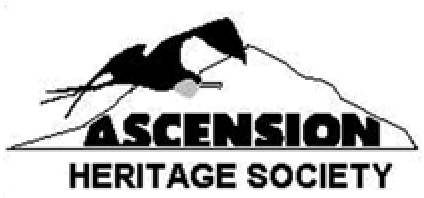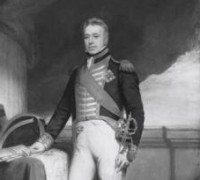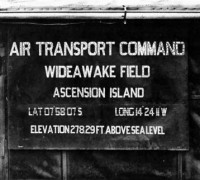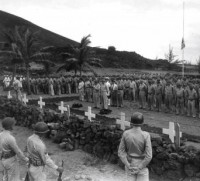ASCENSION ISLAND AND THE SECOND WORLD WAR - ASCENSION ISLAND IN THE WAR
6)1944 1945 THE WAR ENDS
BY DAVID FONTAINE MITCHELL
On 2 February Captain R.W.C. Byrne relinquished command of the AVDF and was replaced by Sergeant Major G. Addison-Williamson, who served as the senior NCO in command. Gen. Wooten visited the island again with his staff for an inspection on 28 February, departing on 2 March. Interestingly, Ascension’s first monkey arrived on 4 March after a PB4Y-1 landed from Natal en route to the Azores. The crew was carrying their pet monkey aboard the flight, and the animal managed to escape during their one-night layover on the island. Unable to recover their pet, the crew took off the next morning with the creature still at large.
On 6 March, the famous RAF Liberator Commando AL504 became the first aircraft to fly 2,400 miles directly from Cape Town to Ascension, making the flight in 14 hours and 16 minutes. The aircraft, which had been previously used by Winston Churchill, was carrying multiple passengers tasked with investigating British telecommunications services worldwide. During their 70,000-mile tour, the “Empire Telecommunications Commission” had stopped on Ascension to refuel before departing for Natal. Unfortunately, the tour was never completed as the Commando crashed into the sea later that month on 27 March during a flight from Britain to the Azores archipelago, killing everyone onboard.
The U.S. Navy detachment ceased activity on 20 June, relinquishing their duties to the U.S. Army. The detachment departed the island 10 days later by air for Brazil. A phased withdrawal from Ascension had begun and the various outposts situated around the island were abandoned. Several of the Coast Artillery guns and two of the radio-location detector stations were also dismantled around this time. Also, the Signal Unit was being incrementally phased out and departing via aircraft. The Royal Navy’s HF signals station closed down on 11 June and was subsequently taken over by C&W. The men departed aboard the HMS Fal on 15 July en route to Freetown, and all RN activities on Ascension ceased on 2 August. The last of the 692nd Signal Corps and the 91st Infantry departed on 25 August onboard the USS Madison.
In September only 40 aircraft landed on Ascension. The monthly average of planes received by Wideawake Airfield from September 1945 to June 1946 was 41. The Madison returned once again to transport more troops from the island, departing on 17 September with 340 U.S. servicemen. Wooten made his final inspection visit on 28 October and by then most of the buildings had started to be dismantled. The remaining personnel stationed at the 175th Field Hospital were transferred to the airfield, abandoning the original structures at the base of Green Mountain. The U.S. military had increased their withdrawal speed and just 450 men remained, a significant decrease from the roughly 4,000 that were stationed on Ascension in mid-1943 during the height of activity. “Task,” the daily newssheet, ceased publication on 9 September. The No. 90 Staging Post was closed on 2 December and all Royal Air Force personnel departed on 9 December. By the end of 1945 only 225 men remained on Ascension.
The year 1946 was relatively quiet with only 82 U.S. servicemen stationed on the island. The men remained there until 1947, when the airfield finally closed. In March of that year, the War Department in Washington made the decision to close the airfield and withdraw the remaining personnel, and on 31 May the airfield was deactivated and all remaining men were evacuated. Although the soldiers deconstructed several buildings prior to their departure, many structures remained untouched and abandoned. Ammunitions were buried or cached, while several fragmentation bombs were destroyed on-site. Massive amounts of fuel were also left behind, so much in fact that it was able to power all of the cars on the island for over a decade. The HF station was handed over to the 200 remaining C&W workers, who subsequently converted it into a homing beacon transmitter. C&W reassumed control of the island in 1947 and the island went back to housing roughly only 170 residents.
Although the military had departed, it wasn’t long before they returned. Recognizing the significance of the base, the U.S. government reached an agreement with Britain to re-establish a presence on Ascension in 1956. The U.S. Air Force (USAF) arrived and began work on upgrading Wideawake Field, extending the runway so that larger aircraft could land. An Eastern Test Range station was erected in 1957, which was used to track and monitor missiles launched from Cape Canaveral. A decade later, in 1967, NASA established a tracking station which supported the agency’s global communications network. Involved in the Apollo lunar landing program, the station proved to be a vital link in the network. NASA has since departed, but the USAF continues to support the agency’s endeavors from the island. Aside from assisting with NASA and the Cold War effort, Ascension was also utilized during the Falkland Islands conflict in 1982. RAF pilots would land on the airfield to refuel while en route to the Falklands, and a detachment is still present on the island today. The RAF continues to make flights between the UK and the Falklands, and the weekly stop on Ascension is the only form of transportation to and from the island. Civilians can visit only if permission has first been granted by the island’s administrator.
The arrival of the 38th Engineers in March of 1942 drastically altered the face of the island, and forever thereafter it has been used in various capacities by the U.S. and British governments. The militarization of the island has served the national security interests of the two nations for roughly seven decades, and it continues to serve as an important asset, albeit one that is largely overlooked. The airfield on Ascension proved vital to the defeat of Rommel in North Africa and contributed heavily to operations in Sicily and Italy throughout the war. The island also served as a refueling station for aircraft en route to the Middle East and the China Burma India Theater (CBI). From 1943 to 1944, over 25,000 aircraft landed on Wideawake Field on their way to assisting the Allied war effort. Numerous German U-boats were sunk as a result of the antisubmarine patrols that were coordinated from the base, dampening Axis naval pursuits in the South Atlantic. Ascension’s contribution to the war effort is perhaps best summarized by Col. Mullenix in a 1944 letter to Cable and Wireless:
"Ascension Island has played a unique and vital part in the war…Without the existence of Ascension, without its active facilitation of the movement of our airplanes, the indispensable aviation support for our troops in North Africa could not have been accomplished at the critical period when Rommel and his Afrika Corps were literally assaulting the gates of Cairo. That aviation passed through Ascension safely and surely played its decisive part in driving the German and Italian forces from North Africa."
ACKNOWLEDGEMENTS
List of Sources
Avis, Graham. 2001. An Introduction to the History of Ascension Island: Second edition. Ascension Island Heritage Society: Ascension Island.
Cannan, Edward. 1992. Churches of the South Atlantic Islands: 1502-1991. Anthony Nelson: Shropshire, England.
Cant, Jeff. 1993. Ascension at War: Ascension Island: South Atlantic Ocean. Ascension Island Historical Society:
Ascension Island. 1995. No. 90 Staging Post: The Role Played by the Royal Air Force on Ascension Island during the Second World War. Ascension Island Heritage Society: Ascension Island. A Chronology of Ascension Island during the Second World War.
Clarke, Frederick J. 1944. Ascension Island, an Engineering Victory. National Geographic, Vol. 85, 623-640.
Cross, Tony. 1980. St. Helena: Including Ascension Island and Tristan da Cunha. David & Charles: London.
Dmitri, Ivan. 1944. Flight to Everywhere. Whittlesey House McGraw-Hill: New York.
Ford, Eric H. 1933. The History and Postage Stamps of Ascension Island. E.H. Ford: London.
Gaines, William C. 2006. 28th Coast Artillery Battalion and the Defense of Saint Lucia and Ascension Islands. The Coast Defense Journal, Vol. 20, No. 3 (August) : 4-22.
Ghione, Sergio. 2003. Turtle Island: A Journey to the World’s Most Remote Island. Thomas Dunne Books: New York.
Grelish, Tom. 2007. Putting in a Little Overtime: The 38th Engineers Embark on an ‘Endless’ 90-Day Tour.
World War II, March.
Hendricks, Charles. 1992. Building the Atlantic Bases. In Builders and Fighters: U.S. Army Engineers in World War II, ed. Barry W. Fowle, 27-45. U.S. Army Corps of Engineers: Fort Belvoir, Virginia.
Hart-Davis, Duff. 1973. Ascension: The Story of a South Atlantic Island. Doubleday & Company: Garden City, New York.
Moore, W. Robert. 1945. Greens Grow for GI’s on Soilless Ascension. National Geographic, Vol. 88, 219-230.
Parkhill, Shari D. 2009. The Americans on Ascension: World War II: Caring for Body, Heart and Soul: Second edition. Ascension Island Heritage Society: Ascension Island.
Ritsema, Alex. 2006. A Dutch Castaway on Ascension Island in 1725. Alex Ritsema: Deventer, The Netherlands.
Royle, Stephen A. 2004. “The Island has been Handed over to me”: Ascension Island as a Company Colony, 1922-42. Singapore Journal of Tropical Geography, Vol. 24, No. 1, 109-126.
Winchester, Simon. 2004. Outposts: Journeys to the Surviving Relics of the British Empire. Harper Perennial: New York.

Ascension Island Heritage Society
PO Box 254235
Patrick AFB FL 32925-0235 www.heritage.org.ac



